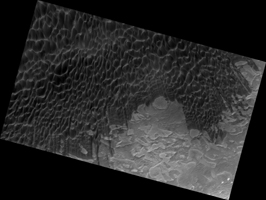
Map Projected Browse Image
Click on image for larger versionMega-ripples are distinct wind-driven formations that occur on the surface of Earth and Mars, often with sizes between that of smaller ripples and larger dunes. Based on their shapes and examples of fractured crests in some areas, mega-ripples are thought to be largely inactive relics of past climates. Thanks to repeat coverage by HiRISE, we can tell that some mega-ripple fields are active and migrating alongside dunes and ripples.
In a down-wind perspective view we can see mega-ripples collecting along the flanks of the dark sand dunes near the North Polar deposits. A closer look illustrates the fine scale details of some active mega-ripples during the summer.
Landforms across these North Polar latitudes become ice-cemented when wintertime carbon dioxide ice buries dunes. Then the ice sublimates through the northern spring until dunes and mega-ripples become "frost free" and mobile by summer. It is these summertime seasonal winds that drive the enhanced activity of migrating mega-ripples of the North Polar region.
The map is projected here at a scale of 25 centimeters (9.8 inches) per pixel. (The original image scale is 32.0 centimeters [12.6 inches] per pixel [with 1 x 1 binning]; objects on the order of 96 centimeters [37.8 inches] across are resolved.) North is up.
This is a stereo pair with ESP_053384_2640.
The University of Arizona, in Tucson, operates HiRISE, which was built by Ball Aerospace & Technologies Corp., in Boulder, Colorado. NASA's Jet Propulsion Laboratory, a division of Caltech in Pasadena, California, manages the Mars Reconnaissance Orbiter Project for NASA's Science Mission Directorate, Washington.

